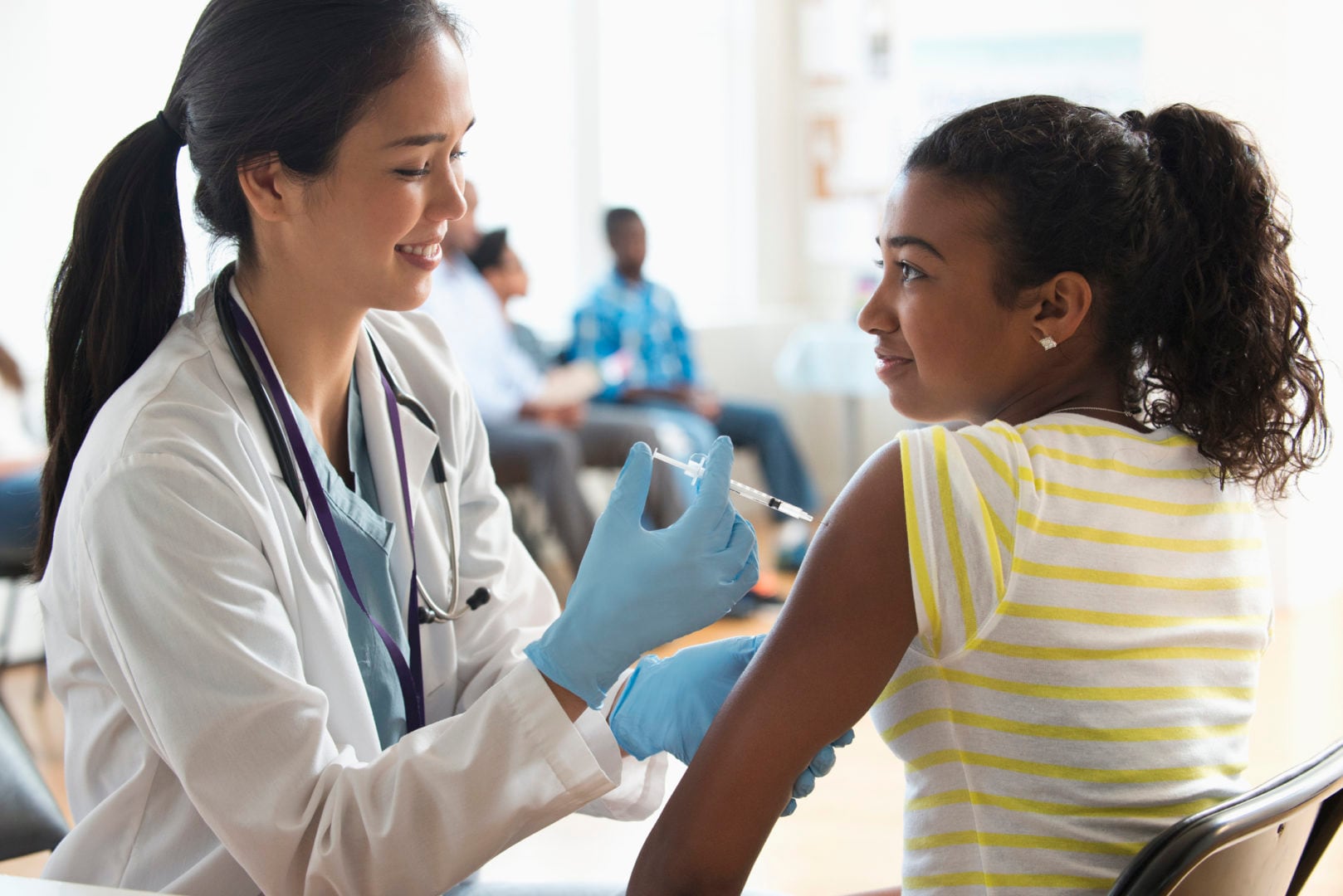In mid-July, director of the Centers for Disease Control and Prevention (CDC) Dr. Robert Redfield said he’s concerned that the fall and the winter of 2020 and 2021 will be “one of the most difficult times that we’ve experienced in American public health.”
He’s not alone. Health officials around the U.S. echo his concerns, encouraging families to take key steps to protect their health and the health of their families with messages like “wash your hands,” “watch your distance,” “wear a mask” and — increasingly — “get vaccinated.”
Dr. Amalia Guardiola, an associate professor of pediatrics at McGovern Medical School at UTHealth in Houston, says vaccination is always important, but it will be particularly important this fall as many states reopen schools and head into flu season with COVID-19 still spreading. Here are five things she and other health experts say parents can do to protect the health of their kids and their family before fall and winter arrive.
1. Get flu shots to reduce the spread of preventable disease
Many business and school-reopening plans rely on screening people for symptoms like fever or cough to protect against COVID-19, but that will be harder to do effectively when cold and flu season strikes, says Theresa Chapple-McGruder, an epidemiologist in Rockville, Maryland.
“Flu-like symptoms and COVID-like symptoms are pretty much the same,” she says. Both diseases can cause symptoms like fever, cough, sore throat and fatigue. As a result, “it’s going to be really hard for us to disentangle flu from COVID.”
What’s more, if schools and businesses have to close several times throughout the year due to disease outbreaks, it could be highly disruptive — not to mention stressful — for everyone.
Families won’t be able to prevent every germ they’re exposed to, which is why Chapple-McGruder says it’s important to prevent the ones you can by staying on top of routine vaccinations, including the flu vaccine, which the CDC recommends for everyone over the age of 6 months.
High flu vaccination rates could also help address another big concern Chapple-McGruder has: how hospital systems will manage COVID-19 and flu at the same time. The CDC estimates that the flu causes anywhere from 140,000-810,000 hospitalizations every year in the U.S. alone. With hospitals already approaching capacity due to COVID-19 spread in some parts of the country, she says they could get overwhelmed when flu season hits.
Once hospitalized, Chapple-McGruder says it’s possible that someone with the flu could end up being exposed to COVID-19 or vice versa. While the flu alone isn’t as deadly as COVID-19, some research from early in the pandemic showed that having influenza B and COVID-19 at the same time could be three times more deadly than COVID-19 alone.
Guardiola adds that influenza on its own can be dangerous for children. Some kids might have mild symptoms, but she says others can develop serious complications like “respiratory distress, respiratory failure, inflammation of the lungs, and also it can affect other parts of their body.” The CDC reports that 185 children in the U.S. died from flu during the 2019-2020 season.
2. Be aware that COVID-19 isn’t the only disease that can spread quickly in schools
Researchers are still learning the role children play in the spread of the novel coronavirus, but we already know a lot about how quickly germs can spread through schools and day cares. Chapple-McGruder says the pattern is pretty clear.
“You have the start of school and then you have parents calling out of work because children are sick,” Chapple-McGruder says. “That happens every year like clockwork.”
Chapple-McGruder expects precautions being taken to prevent COVID-19 in schools — such as wearing masks, spacing students 6 feet apart and frequent hand-washing — will likely lower the chances of other diseases spreading, too. But, she adds, that’s only if everyone consistently takes precautions, which can be tough for kids to do.
While COVID-19 is a primary concern among parents, teachers and school administrators, other diseases can spread even more quickly and easily than coronavirus, says Chapple-McGruder. Measles, for example, can be 5-7 times more contagious, she says.
3. Prioritize well-child visits before school starts, especially if due for vaccination
When health officials told everyone to stay home last spring to flatten the curve of COVID-19, most people listened. But while families avoided large gatherings, opted out of playdates and limited their trips outside the home, they also steered clear of pediatric offices and cancelled well-child visits, which can include vaccinations. As a result, the number of children vaccinated in the U.S. dropped significantly in March and April, according to the CDC.
Chapple-McGruder says she expects kids will get caught up on vaccines quickly to comply with school vaccine requirements. However, pediatricians are concerned that some schools or child care facilities are heading into the school year with vaccination rates too low to protect against outbreaks.
“The drop in vaccination that was noted this spring is especially concerning for young children that have not received vaccines for highly contagious illness, such as measles,” says Dr. Julie Boom, pediatrician and director of both the Texas Children’s Hospital Immunization Project and Infant and Childhood Immunization for the Center for Vaccine Awareness and Research in Houston.
4. Ask your pediatric office about precautions they’re taking to vaccinate kids safely
After his son was born in early March, Ryan Youngberg, a dad in Oswego, Illinois, and co-founder of the site Baby’s Journey, was one of the parents who chose to delay vaccines.
“[The pediatrician] left it up to us, and we decided against going due to concerns with bringing our newborn to the doctor with potentially sick kids,” Youngberg says. A few months later, however, they decided to bring in their son for his 3-month checkup and to get him caught up on his vaccinations.
Like many pediatric offices across the country, Youngberg’s pediatrician had put in place precautions to protect patients and staff from COVID-19.
“The clinic had a new process where we could check in from our car, and they would call when the room was ready, rather than sitting in the waiting room,” he says. “They also split the schedule so that well-child and sick visits are on different days. This helped alleviate much of the anxiety we previously had.”
In the fall, Youngberg says his family will be getting their flu shots, too. “We are not taking any chances.”
Boom says her office has been giving vaccines throughout the crisis and reminding her patients of the importance of well-child visits, especially for younger children who might need vaccines. So has Guardiola.
“We are calling all our patients that we see are due for vaccinations,” she says, and reassuring them that staff are taking every precaution to protect kids when they come in for vaccines.
5. Find out how to protect your family even if you don’t have health insurance
The recession and subsequent layoffs brought on by the COVID-19 crisis have left many families without health insurance, but programs are available to vaccinate uninsured kids or those whose families can’t afford to pay, Boom says.
She points to Vaccines for Children (VFC), a federally funded program that gives vaccines to clinics and health departments so that they can vaccinate children at no or low cost. Many providers’ offices — including private practices and those in rural areas — participate in VFC, Boom says. Parents should ask their pediatrician or family physician if they participate in the program and if not, contact their local health department to find a provider who does.
“Many parents want to ensure they are doing everything they can to keep their child healthy,” Boom says. “Timely vaccination is definitely critical to keeping children healthy.”






